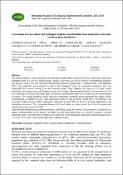Options
Correlation between odour and hydrogen sulphide concentrations from municipal wastewater treatment plant immissions
ISSN
2668-8530
Date issued
2023-12
Author(s)
DOI
10.21698/rjeec.2023.210
Abstract
The study focused on odours generated by hydrogen sulphide (H2S) immissions from a municipal wastewater treatment plant in a city of 2 million people. Odour awareness was vital to monitor environmental pollution and human safety. H2S was released from the decomposition of organic matter, sulfites (SO32-), and sulfates (SO42-) by anaerobic microorganisms used in the biological stage of wastewater treatment. H2S was responsible for odours coming from the treatment plant. Long exposure (8 hours) to 2-5 ppm causes headaches and watery eyes, and 50 ppm irritates the airways. Maximum permissible concentrations for H2S are 0.006 ppm (24 hours) and 0.011 ppm (30 minutes). In Romania, there are no limits on the concentration of odours. The sludge pumping station from the wastewater treatment plant registered the highest odour concentration at 36.000 OUE/m3, with significant levels of H2S primarily found there. Nevertheless, the activated sludge aeration system effectively eliminated around 99% of the H2S through degradation and absorption processes. The correlation between H2S and odour has been proved by a directly proportional relationship with a ratio of 25.000. Experimental determinations and mathematical modeling, using the Aermod View program, contributed to a deeper understanding of the impact of odours on the environment and sensitive receptors, showed maximum odour concentrations of 38.8 ouE/m3 at the site of the municipal wastewater treatment plant and 5 ÷7 ouE/m3 at receptors, but without affecting residential areas.
Files
Loading...
Name
Articol 10 Proceedings.pdf
Description
Proceedings paper
Size
1.67 MB
Format
Adobe PDF
Checksum
(MD5):6e7cbedcd5237f9b65cd68368694d01b